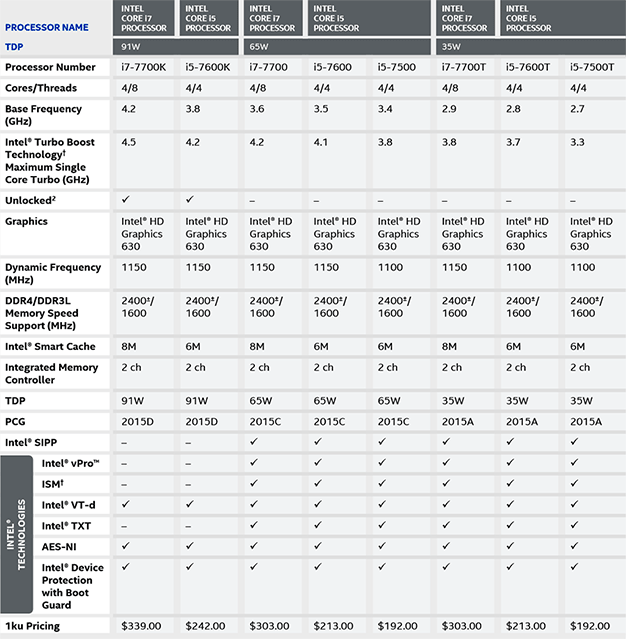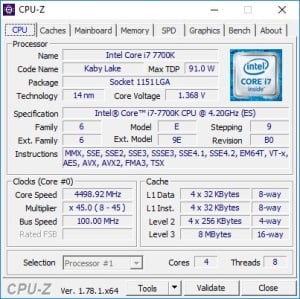Intel Core i7-7700K And Z270 Chipset Review: Kaby Lake Hits The Desktop
The Core i7-7700K has hardly been a secret. The processors actually went on sale at a couple of major on-line retailers recently and benchmark numbers have been trickling out for weeks now. We’ve got one in house for testing, along with some new memory from G.SKILL and a few killer motherboards from Gigabyte and Asus, built around the Z270 chipset. We’ve also got some details regarding the rest of the Kaby Lake desktop line-up. Take a look at a few features and specifications in the table below and then we’ll dig in a little deeper, cover Intel’s new chipsets, and see how the Core i7-7700K fares against an array of competing products...
|
The Intel Core i7-7700K's full specifications, along with some lower-end Core i5s are listed above. But the Kaby Lake architecture will power a wide array of products from 4.5W on up 91W, covering Core i and Xeon branded processors.
As you can see, the 7700K a quad-core CPU that can process up to 8 threads simultaneously (4C/8T), thanks to Intel’s HyperThreading technology. Other features include a DX12-capable HD 630 series graphics engine with updated multimedia engine that can now accelerate 4K HEVC 10-bit transcoding and VP9 decoding in hardware. Other features include things carried over from previous generation Intel processors like Smart Cache and AES-NI, among others.
In terms of its packaging, the Core i7-7700K looks just like other Intel LGA based processors. It uses the same 1151 LGA as Skylake and the heat-spreader design on the top is the same as previous-gen parts as well. The underside, however, has a slightly different pad configuration. The array of caps and pads in the center of the underside are in a different arrangement than previous-gen processors to accomadate Kaby Lake's power requirements.
We don’t have many new details on the HD 630 series GPU built-into the Core i7-7700K, because there really aren't any, but performance is marginally better than the HD 530 series. Virtually all of the additional performance (which isn’t much) comes by way of its ability to maintain boost clocks longer, thanks to Kaby Lake’s new transistor mix – the actual peak GPU frequency is the same as the HD 530. The HD 630 series GPU core can boost up to 1150MHz and can power up to 3 displays simultaneously. The graphics core is also DX12-compatible, though it is not powerful enough for the latest and greatest games.
The Core i7-7700K has a base clock of 4.2GHz with a max turbo frequency of 4.5GHz, though with SpeedStep the chip will drop down to only 800MHz when idle. It has a TDP of 91W and over 8MB of total cache on-board, 256K of L1 (64K per core), 1MB of L2 cache (256K per core), and 8MB of L3, which is a similar cache hierarchy to Skylake.
Though Kaby Lake is touted as a new microarchitecture, it obviously borrows heavily from its predecessors – it is very similar to Skylake, but with an updated multimedia engine and new transistor mix, that allows for higher clocks. Intel’s SpeedShift technology has also been tweaked to allow for even faster state changes. For more detail on the changes in Kaby Lake, we suggest taking a look at our launch coverage here.












